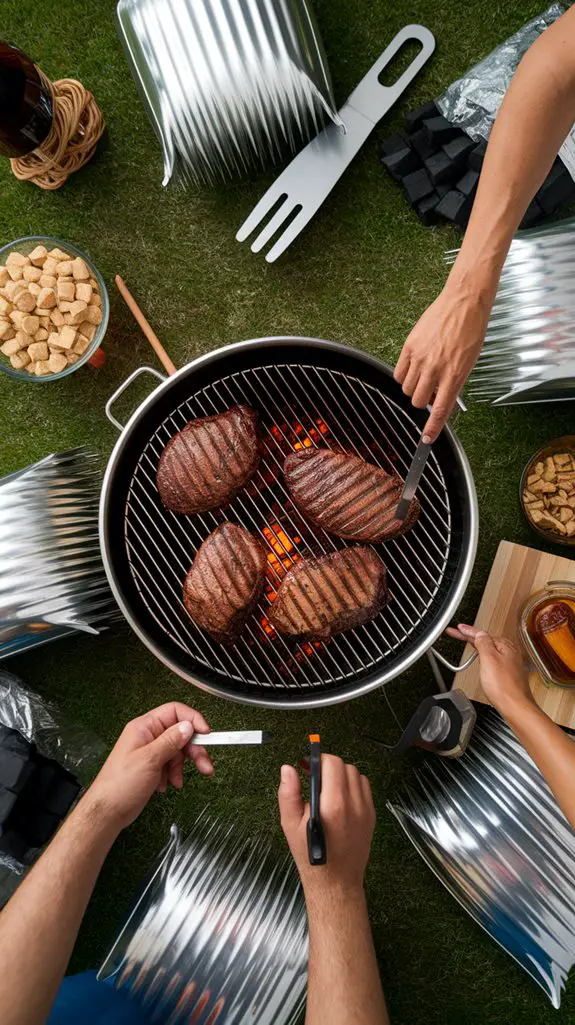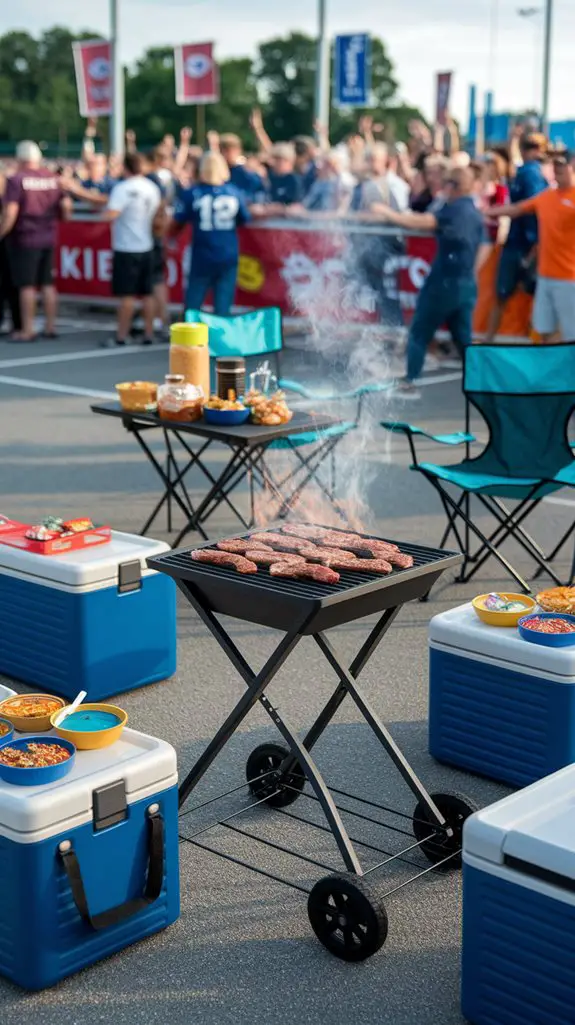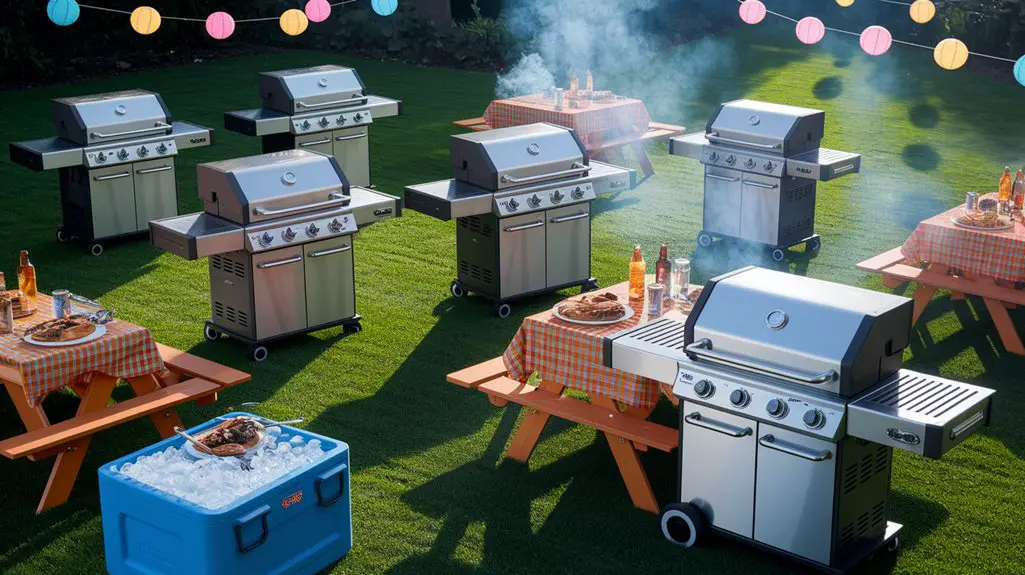Your tailgating BBQ setup can be the difference between a mediocre game day and a legendary one that fans still talk about seasons later. You’ll need to master both the technical and tactical aspects of parking lot grilling to elevate your pre-game experience. From selecting the right portable equipment to orchestrating an efficient cooking space, your success depends on thoughtful preparation and strategic execution. The following seven tips will transform your tailgate from amateur hour to professional-grade entertainment.
Choosing the Right Portable Grill for Game Day
When selecting a portable grill for tailgating, the balance between mobility and cooking capacity becomes your primary consideration.
Propane models offer immediate heat and temperature control without the mess of charcoal, while compact charcoal grills deliver authentic smoky flavor despite longer heating times.
Evaluate BTU ratings (8,000-20,000 ideal for tailgating) and cooking surface area (200-285 square inches accommodates 10-12 burgers simultaneously).
Folding legs and collapsible designs greatly reduce transport volume. Prioritize units under 30 pounds with sturdy handles.
For fuel efficiency, look for models with insulated lids and adjustable vents. Wind guards prevent flame-outs in stadium parking lots.
Integrated thermometers eliminate guesswork for proper cooking temperatures.
Cast iron grates retain heat better than stainless steel but require more maintenance between games. Additionally, consider customizing your setup with customizable BBQ grill setups to enhance your overall tailgating experience.
Essential Grilling Tools and Equipment for Tailgating

Beyond selecting the ideal portable grill, the accompanying toolkit determines your tailgating success.
Pack heat-resistant gloves rated for 932°F to handle hot grates and coals safely. Include a digital instant-read thermometer with ±1°F accuracy to guarantee proper cooking temperatures—particularly vital for poultry and pork.
Don’t overlook a sturdy metal spatula with beveled edge for clean flipping, long-handled tongs (16″ minimum) for precise food manipulation, and a grill brush with replaceable heads for between-cook cleaning.
Add a cooking surface thermometer to monitor grate temperature, aluminum foil for creating heat zones, and silicone basting brushes for sauce application.
Store everything in a dedicated weather-resistant container that withstands transport vibration and protects tools from game day elements.
Space-Saving Setup Strategies for Parking Lot Cooking

Maximizing every square inch becomes essential while orchestrating a tailgate grilling operation in crowded parking lots.
Strategic configuration of your cooking zones creates efficient workflow without impinging on neighboring fans’ spaces. Implement these space-optimization techniques to transform your limited footprint into a functional outdoor kitchen:
- Position your grill perpendicular to your vehicle’s rear bumper to create a natural serving corridor.
- Utilize collapsible tables with adjustable heights to accommodate prep, cooking, and serving needs.
- Install magnetic hooks on your vehicle’s exterior for hanging tongs, spatulas, and other tools.
- Stack storage containers vertically with frequently used items on top for accessibility.
- Deploy pop-up canopies with retractable sidewalls that can adapt to varying weather conditions and crowd sizes.
- Consider integrating a beverage station into your setup to streamline drink access while conserving space.
Fuel Options and Safety Considerations
The foundation of any successful tailgating experience rests upon selecting the appropriate fuel source and implementing rigorous safety protocols in crowded stadium environments.
Propane offers clean-burning convenience with precise temperature control, while charcoal delivers superior flavor profiles at the cost of longer ignition times. Never use gasoline as an accelerant.
Always position your grill at least 10 feet from vehicles and combustible structures. Bring a Class B fire extinguisher rated for grease and fuel fires—water exacerbates these emergencies.
Monitor wind direction to prevent smoke from disrupting neighboring tailgaters or triggering smoke alarms in nearby structures.
For disposal, fully extinguish charcoal with water and confirm no heat remains before discarding in designated receptacles.
With propane systems, inspect connections for leaks using soapy water before each use. Additionally, incorporating stylish BBQ grill setups can enhance your overall tailgating atmosphere.
Weather-Proofing Your Tailgate Grilling Station
Weather conditions can quickly transform your meticulously planned tailgate from triumphant to disastrous if you haven’t properly weatherproofed your grilling station.
Implement these critical protective measures to guarantee uninterrupted cooking regardless of meteorological challenges.
- Secure a portable 10’×10′ pop-up canopy with weighted anchors to shield your grilling area from precipitation and direct sunlight.
- Position your setup with the grill facing away from prevailing winds to minimize flame disruption and maintain consistent cooking temperatures.
- Apply silicone covers to electrical connections and utilize waterproof extension cords rated for outdoor use.
- Install magnetic grill light fixtures for visibility during unexpected darkness or early sunset conditions.
- Pack thermal insulating barriers for your coolers and food storage units to maintain safe temperatures during extreme heat or cold fronts.
Quick-Prep Food Ideas for Efficient Tailgate Grilling
Successful tailgate grilling hinges on strategic food selection that minimizes prep time while maximizing flavor impact.
Pre-marinate proteins 24 hours ahead in vacuum-sealed bags, focusing on items with 8-12 minute cook times like chicken skewers, flat iron steaks, or pre-formed sliders.
Leverage par-cooking techniques for longer-cooking items—smoke ribs to 145°F internal temperature at home, then finish at your tailgate site.
Prepare compound butters and sauce reductions in advance, storing in squeeze bottles for precise application.
Consider aluminum foil packet systems for vegetables—dice bell peppers, onions, and zucchini uniformly at 3/4″ for consistent cooking, then season and seal for direct grill placement.
Cleaning and Packing Tips for Post-Game Departure
Efficient post-tailgate breakdown requires systematic preparation long before kick-off time to guarantee you’re not left scrambling while others have already departed the parking lot.
Implement a reverse-order packing strategy that prioritizes cool-down periods for hot equipment and minimizes cross-contamination.
- Bring heat-resistant gloves and a metal ash container for safe disposal of hot coals
- Pack heavy-duty aluminum foil to wrap grill grates while still warm for steam cleaning
- Use designated plastic bins with lids for dirty utensils to prevent grease transfer
- Store a spray bottle with vinegar-water solution for quick degreasing of surfaces
- Employ a checklist system on your phone to verify all equipment is accounted for
- Consider using shade and shelter options to enhance your BBQ experience and protect your setup from the elements.
Conclusion
Your tailgate BBQ setup isn’t just about the food—it’s about efficiency and safety in limited space. Implement these seven strategies to maximize your game day experience while minimizing logistics challenges. Studies show that 65% of tailgaters spend over three hours pre-game, making your grill configuration critical for sustained cooking performance. By optimizing your equipment selection, spatial arrangement, and preparation workflow, you’ll elevate both cooking outcomes and overall tailgating enjoyment.




